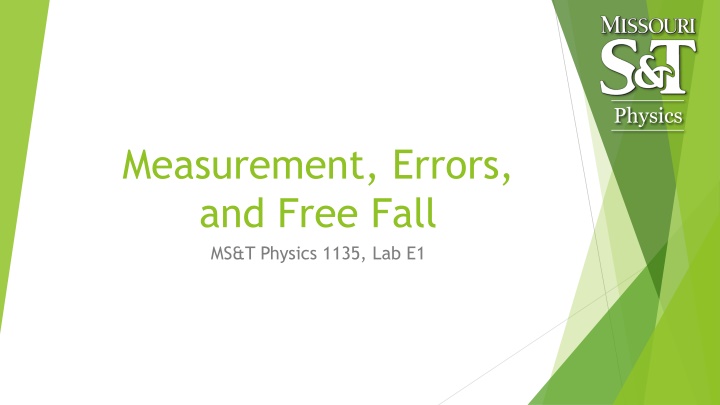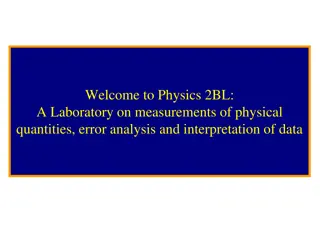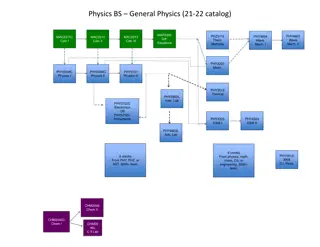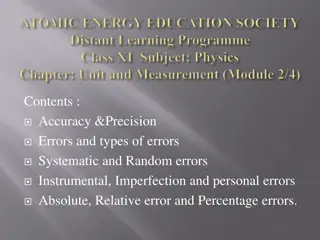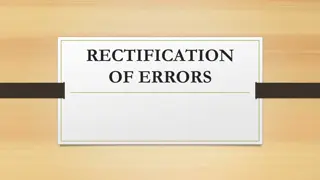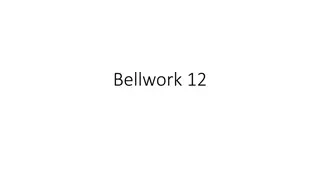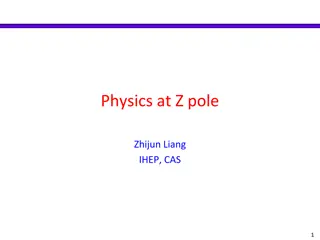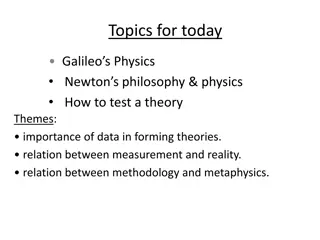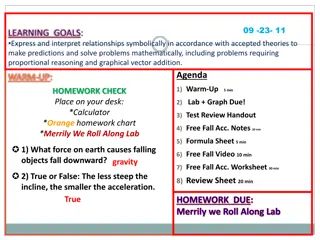Physics Measurement, Errors, and Free Fall Lab
In this physics lab, students learn to use Vernier calipers, review standard deviation, determine errors in calculated quantities, and experimentally determine the value of g by measuring the time it takes for an object to fall a distance. The lab also covers the precision of measuring instruments and error analysis in mathematical operations. Practical demonstrations and software tools like Excel and Capstone are utilized for data analysis.
Download Presentation

Please find below an Image/Link to download the presentation.
The content on the website is provided AS IS for your information and personal use only. It may not be sold, licensed, or shared on other websites without obtaining consent from the author.If you encounter any issues during the download, it is possible that the publisher has removed the file from their server.
You are allowed to download the files provided on this website for personal or commercial use, subject to the condition that they are used lawfully. All files are the property of their respective owners.
The content on the website is provided AS IS for your information and personal use only. It may not be sold, licensed, or shared on other websites without obtaining consent from the author.
E N D
Presentation Transcript
Physics Measurement, Errors, and Free Fall MS&T Physics 1135, Lab E1
Objectives: Part I Physics Learn to use Vernier calipers. Learn the precision of measuring instruments. Review standard deviation. Review use of Excel and Capstone. Learn how to determine the error in calculated quantities. Note: You must provide several sections for each lab report in this class. Details regarding what information belongs in each of these sections can be found in the General Information section at the beginning of your lab manual. If you have any questions that are not answered there, consult your lab instructor. MS&T Physics 1135, Lab E1: Measurement, Error, Free Fall Slide 2/8
Part I: Measurement and Errors L L Physics D D Suppose we have a stick of length L L and we cut off a length D D. There are four possibilities for the length of the remaining piece: ? + ? ? + ? = ? ? + ? ? ? + ? ? ? = ? ? + ? + ? ? ? ? + ? = ? ? ? + ? ? ? ? ? = ? ? ? ? Longest Shortest The remaining length, then, lies in the range defined by (L-D) ( L+ D). The same holds for addition, so errors add over addition and subtraction. MS&T Physics 1135, Lab E1: Measurement, Error, Free Fall Slide 3/8
Part I: Measurement and Errors Physics This process can be applied to multiplication and division as well. Four possibilities exist for the area of a rectangle of sides a a and b b: ? + ? ? + ? = ?? + ? ? + ? ? + ? ? ? + ? ? ? = ?? ? ? + ? ? ? ? ? ? ? + ? = ?? + ? ? ? ? ? ? ? ? ? ? = ?? ? ? ? ? + ? ? The product a b is small enough to be negligible As shown in the manual, this means the relative errors add when multiplying two quantities with small errors: ? = ? + ? ? + ? ??= ??+ ?? From there, we can find the error associated with our measurement of X: ? ?+ ? ? = ???= ? ??+ ?? = ? ? MS&T Physics 1135, Lab E1: Measurement, Error, Free Fall Slide 4/8
Objectives: Part II Physics Measure the time it takes an object to fall a distance H and use this to experimentally determine the value of g. MS&T Physics 1135, Lab E1: Measurement, Error, Free Fall Slide 5/8
Part II: Free Fall Physics The pane on the left in Capstone changes based on which tool is selected. Clicking the currently selected tool hides the pane from view. Select the Hardware Setup tool and add a Free Fall Adapter to Digital Input 1. MS&T Physics 1135, Lab E1: Measurement, Error, Free Fall Slide 6/8
Part II: Free Fall Physics The steps shown at right will create a digital display for the Time of Fall measurement. You could use a table as well. The process is similar, but tables in Capstone have two columns by default. We only need one column, so either ignore or delete the other. Click Record when you are ready to start collecting data. MS&T Physics 1135, Lab E1: Measurement, Error, Free Fall Slide 7/8
Notes on Part II Physics The free fall apparatus is a fairly simple device: the clamp at the top closes the circuit when the steel ball is in place, and the plate at the bottom closes the circuit again when the ball impacts it. The time recorded, then, is the elapsed time that the circuit was open. This simplicity leads to a tendency to record false data: the device can t distinguish between the ball impacting the plate and the clamp being closed twice. You must be able to recognize these false readings and discard them! The lab manual mentions two distinct ways to estimate measurement error. Know which one to use for each measured value, and know how to use those to find the error in any calculated values. You will do this repeatedly in this course, so you would do well to understand it now! MS&T Physics 1135, Lab E1: Measurement, Error, Free Fall Slide 8/8
